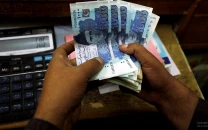Ministry alleges NEPRA caused Rs90 billion loss
Says lower tariffs set by the regulator put undue burden on power sector

The water and power ministry wants to amend the Nepra Act to bring the regulator under its supervision. PHOTO: AFP
“The lower tariff set by the regulator for power distribution and generation companies will put undue financial burden on the sector and the federal budget if corrective measures are not taken,” said a senior official of the ministry.
Cheaper fuel prices: NEPRA approves tariff cut of Rs2.56 per unit
The Rs90-billion figure included Rs60-billion loss to distribution companies due to tariff reduction and Rs30-billion loss to generation companies following determination of lower tariffs, especially for the Nandipur power plant.
Because of this reason, the Ministry of Water and Power has not yet notified the tariff for the Nandipur plant.
However, while announcing its decision on a petition for fuel price adjustment in the power tariff for September 2016, the regulator voiced serious concern over the delay in notifying the tariff for the Nandipur plant. The official alleged that Nepra was not performing its duties according to its mandate, which would have an adverse impact on the performance of power companies. This was the reason why the water and power ministry wanted to amend the Nepra Act to bring the regulator under its supervision, he said.
“If this plan is implemented and Nepra is brought under control of the ministry, the regulator, which is supposed to safeguard the interest of consumers, will become toothless,” argued another government official.
Despite efforts, Nepra could not be reached for comments. Apart from the losses caused by lower tariffs, the power companies were also finding it tough to cope with subsidy payments and general sales tax (GST) refunds.
This is creating hurdles in the way of generating funds for critical power production projects aimed at easing energy shortages in the country.
According to the official, subsidy payments amounted to Rs5 billion for the months of July and August 2016. At present, the government is providing an annual subsidy of more than Rs100 billion to the electricity consumers.
Subsidy payments valuing Rs98 billion were outstanding in respect of Azad Jammu and Kashmir, Federally Administered Tribal Areas (Fata) and K-Electric by the end of August 2016.
Claims of Rs62 billion on account of GST refund were also outstanding by the end of August.
The official pointed out that with the planned increase of 10,000 megawatts in electricity production over the next two years, the subsidy bill would also go up. In addition to this, the electricity distribution system, which is already under stress, will be unable to bear the load of 10,000MW.
‘Power loom sector on verge of destruction’
In 2013, more than 750 instances of system constraints were recorded in power distribution, but they have now come down to 500. The tripping of feeders has been reduced significantly. A few constraints in the distribution system will, however, remain beyond FY17, especially in some parts of Sindh and Khyber-Pakhtunkhwa.
Published in The Express Tribune, October 29th, 2016.
Like Business on Facebook, follow @TribuneBiz on Twitter to stay informed and join in the conversation.


1728020501-0/Express-Tribune-Web-(13)1728020501-0-208x130.webp)
















COMMENTS
Comments are moderated and generally will be posted if they are on-topic and not abusive.
For more information, please see our Comments FAQ